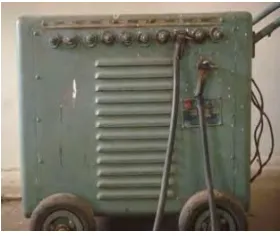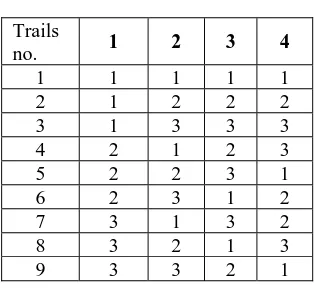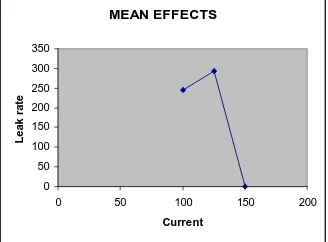Optimization of Shielded Metal Arc
Welding Parameters for Welding of Pipes
by using Taguchi Approach
B.S.PRAVEEN KUMAR *
Assistant professor, Mechanical Engineering Department Government Engineering College, K.R.Pet-571426 (Affiliated to Visveswaraiah Technological University, Belguam)
Karnataka State India.
Email: mepraveenkumar@Gmail.com Mobile No: 09611290235
Fax no.08230-262873
Dr. Y. VIJAYAKUMAR
Principal, Sri Bhagavan Mahaveer Jain College of Engineering JAIN University, Global Campus, Jakkasandra Post,
Bangalore Rural – 562112, Karnataka State, India
Email: kumar_vy@rediffmail.com, y.vijaykumar@jainuniversity.ac.in Mobile No:09845748949
Fax No. 080 27577199
ABSTRACT
The objective of this paper is to Design Parameters for Shielded Metal Arc Welding to ensure no leak to occur during the process. To achieve the objective an attempt has been made to select important welding parameters like welding current, welding speed, root gap and position of electrode based on field expert’s suggestions, available literature and on scientific reasons. On the selected parameters, trails have been conducted as per Taguchi method and fixed the levels for the parameters. Further, for each parameter 3 different levels are fixed,. so that the experiment have become 4 parameters (factors) and each with 3 levels. Based on this, L9 (34) Orthogonal Array (OA) experiments are conducted and results are obtained. The results have indicated that leak proof joints can be produced in few specific operating conditions. Under these conditions effects of noise are nullified. The contribution of each parameter towards the leak is also estimated by ANOVA.
Keywords: Welding parameters; Taguchi technique; Shielded metal are welding (SMAW);
Optimization; Orthogonal array; Sum of squares; Variation and Contribution.
1. INTRODUCTION:
In recent years the welding industry has improved significantly in terms of large number of welding methods suitable for various applications. For particular task or application the existing welding processes are modified suitably to give best results. Further the use of robots for welding application enhanced the strength and capability of the industry. The Robots can sense the varying gap between two pieces to be welded and based on this feed back, it can change the weaving length. However in welding, maintaining Quality is still a challenging task [1-3]. This is due to the fact that there are many number of variables at play. Variation in raw material (composition, thickness, internal defects, etc) variation in the surface condition (presence of dust, grease and oil),change of operator, variation in the gap between two pieces to be welded, variation of welding speed and possible variation in electrodes[4]. The welding variables are categorized into two groups, one is controlled variable and the other is uncontrolled variables. The controlled variables are Current, Voltage, Weld gap, Weld metal deposition. Welding speed, Surface cleanliness, Arc length and Preheating temperature. The uncontrolled variables are Weld bead dimensions, Heat affected zone (HAZ), Wed penetration, distortion, Strength and leak in joints. The controlled variables are either directly or indirectly form the welding process parameters and the uncontrolled variables are the quality characteristics, but mechanism connecting these two is not known accurately and scientifically [5-7]. Therefore experimental optimization of any welding process is often a very costly and time consuming task. In light above the researcher wants to use taguchi’s design of parameters to ensure no leakage
2. EXPERIMENTAL DETAILS:
Welding operation is conducted on Apollo steel tube of diameter 60 mm, with 3mm and 4mm wall thickness, by using a 3 phase (Johnson arc welding transformer) welding machine and is shown in figure1. The electrodes used for the process is Don arc make (AWS Code E6013) of diameter 3mm and 4mm to weld 3mm and 4mm wall thickness pipes respectively. The welding joints are tested for leak testing by using hydraulic hand pump of capacity 400 bars, at 30 bars and the leak testing setup is shown in figure 2. During welding operation the tube is fixed in welding spinner and welded in 5G position as shown in figure 3.and in figure 4 shows welded tubes are shown.
Fig. 1 Johnson arc welding transformer Fig. 2 Leak testing setup
2.1 IDENTIFYING THE PROCESS PARAMETERS AND THEIR LEVELS:
Based on field experts suggestion, literature survey and on scientific reasons following welding parameters or factor are selected.
1. Welding current 2. Welding speed
3. Root Gap
4. Position of electrode
Sufficient number of trail runs is conducted and for each factor optimum range is fixed. Further, the range is split into 3 levels. At different levels, the selected parameters are welded the tube satisfactorily. The range of factors are given in the following tables 1 and table 2 for the diameter 60mm, with 3mm and 4mm thickness respectively. Similarly factors at different levels are given in table 3 and in the table 4.
Table1. Showing range of factors Table2. Showing range of factors
Table3. Levels of factors and values Table4. Levels of factors and values
2.2 Orthogonal Array
Based on the number factors and levels in each factor L9 (34) OA is selected for both 3mm and 4mm wall thickness with diameter 60mm.The table 5 shows L9 OA.
Factors Min. Max.
Welding current (Amps) 80 100
Welding speed (Rpm) 3.5 5
Electrode position
(degrees) 0 60
Root Gap in (mm)
0 1.5
Factors Min. Max.
Welding current(Amps) 100 150
Welding speed (Rpm) 3.5 5
Electrode position (degrees) 0 60
Root Gap in (mm)
0 1.5
Levels 1 2 3
Welding current(Amps) 100 125 150
Welding speed(Rpm) 3.5 4 5
Electrode position
(degrees) 0 30 60
Root Gap in (mm)
0 0.7 1.5
Levels 1 2 3
Welding current(Amps) 80 90 100
Welding speed (Rpm) 3.5 4 5
Electrode position
(degrees) 0 30 60
Root Gap in (mm)
Table 5. L9 Orthogonal Array
Trails
no. 1 2 3 4
1 1 1 1 1
2 1 2 2 2
3 1 3 3 3
4 2 1 2 3
5 2 2 3 1
6 2 3 1 2
7 3 1 3 2
8 3 2 1 3
9 3 3 2 1
3. Results and discussion
Experiments are conducted as per the L9 O.A. and results of diameter 60mm and thickness 3mm are tabulated in table 6.The results of diameter 60mm and 4mm thickness are tabulated in table 7.
Table 6. Leak test results of diameter 60mm x 3mm pipe
Trails no Leak condition Leak rate
1bar ml/min Remarks
1 Leak 150 Failed at 10 bars
2 No Leak --- ---
3 Leak 450 at three points
4 No leak 300 at two point
5 Leak 308.57 at three point
6 No leak 170 at two points
7 No leak --- ---
8 Leak 40 at two point
9 Leak 20 Seepage
Table 7. Leak test results of diameter 60mm x 4mm pipe
Trails no Leak condition Leak rate 1bar ml/min
Remarks
1 Leak 10 Seepage
2 Leak 275 at three points
3 Leak 450 at two point
4 leak 180 at three points
5 Leak 400 at two point
6 Leak 300 at two point
7 No leak --- ---
8 No Leak --- ---
9 Leak 2.6 Seepage
3. Analysis of Variance (ANOVA)
3.1 ANOVA Computations for diameter 60mm x 3mm pipe
3.2 ANOVA Computations for diameter 60mm x 4mm pipe
Factors SS DOF Variance % contribution
Mean 269895.12 8 --- ---
Current 147472.39 2 147472.39 54.64
Speed 61973.42 2 61973.42 22.96
Electrode position 8518.31 2 8518.31 19.24
Root gap 51929.28 2 51929.28 3.156
For pipe diameter 60mm and 3mm thickness, 9 trail runs are conducted as per OA. Out of 9 trails 2 trails, run 2 and run 7 have given welding joints with no leak. In these trails the temperature gradient and local cooling rate, have supported the solidification of liquid metal without any micro porosity or voids either the weld bead or in the line of joint between parent metal and weld bead [8]. However, by visual inspection of bead dimension, continuity and penetration of both the successful trails. It is found that trail run 7 is superior in quality than the tail run 2.This attributed to the fact that trail run 7 will run at higher current with relatively less welding speed 3.5rpm ( 11mm per sec.).These interpretations are strongly supported by the ANOVA results. As contribution of current is 54.64% and the contribution of welding speed is 22.96%.Figure 5 and Figure 6 shows the variation of mean effects of current and welding speed.
Figure 5. Mean effect plot Figure 6. Mean effect plot
For pipe diameter 60mm and 4mm thickness, 9 trail runs are conducted as per OA. Out of 9 trails 2 trails, run 7 and run 8 have given welding joints with no leak. These trial runs are conducted at 150 Amps. Thus the process is more sensitive to variations the welding current. This is supported by the results of ANOVA. That is contribution welding current is 54.64%, it is very much high than any other parameters. On visual inspection if found that both success full joints are almost same in other aspects like bead dimension, continuity and penetration. Hence both are equally robust.
Figure 7 shows the mean effect plot for variation of leak rate with variation of welding current.
Figure 6. Mean effect plot
M EAN EFFECTS PLOT
0 50 100 150 200 250
0 2 4 6
Welding speed Le a k r a te
MEAN EFFECT PLOTS
0 50 100 150 200 250 300
0 20 40 60 80 100 120
Current L e ak rat e MEAN EFFECTS 0 50 100 150 200 250 300 350
0 50 100 150 200
References:
[1] Balasubramani M. Journal of materials technology, Vol.24 (2008).
[2] Chen Y.H.International journal of materials and product technology, V0l.11 (1996) pp333.
[3] Ross J.R. Taguchi techniques for Quality Engineering, McGraw-Hill, New York.
[4] B.S.Praveen Kumar and Dr, Y.Vijaya Kumar, “Optimum blending of powders to obtain desired Mechanical properties by DOE,’ at
NATCON-2005 proceeding, Ghousia college of engineering, Ramanagaram Bangalore.
[5] Selection of process parameters for Mechanical properties of A1 alloys for centrifugal casting Using Taguchi Method Approach,
Shailesh and Sundarrajan, Indian foundry journal, Vol.51, March, 2005.
[6] Song Liu and Robert.G.Batson (2004) On experimental design for gauge gain in steel tube Manufacturing, Quality Engineering,
Vol.16, No.2, PP269-282.
[7] S.H.Robust design and analysis for quality engineering, Chapman and Hall, New York.


